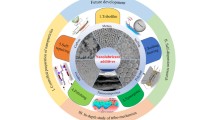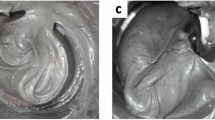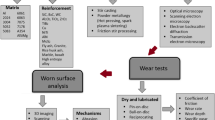Abstract
Friction stir vibration brazing (FSVB) by application of mechanical vibration was introduced in this investigation. In the current research, the adjoining samples are vibrated normally to the brazing line while FSB is performed. Low carbon steel sheets are joined together using FSB and FSVB while SiC nanoparticles are also incorporated in the joint. The microstructure and mechanical behavior of the joints developed under different conditions are analyzed. %67wt Sn-%33wt Pb alloy is used as braze metal. The results show that the strength of the friction stir vibration brazed specimens is higher than that of the friction stir brazed specimens. The vibration of adjoining specimens, during FSVB, enhances the eutectic reaction of the melt braze metal between the adjoining specimens and the melt fills the space between adjoining specimens thoroughly. By introducing vibration during the FSB process, both strain rate and temperature which have fundamental effects on the characteristics of the joints, increase. The results indicate that the strength and the hardness of FSVB-ed samples increase and the grain size decreases as vibration frequency increases from 30 to 60 Hz. In addition, the thickness of IMCs in the joint interface decreased to around 0.7 µm as the vibration frequency increased.
















Similar content being viewed by others
References
Abtew M, Selvaduray G (2000) Lead-free solders in microelectronics. Mater Sci Eng R Rep 27:95–141
Tan AT, Tan AW, Yusof F (2017) Evolution of microstructure and mechanical properties of Cu/SAC305/Cu solder joints under the influence of low ultrasonic power. J Alloy Comp 25:188–197
Mohd Salleh MAA, McDonald SD, Gourlay CM, Yasuda H, Nogita K (2016) Suppression of Cu6Sn5 in Tio2 reinforced solder joints after multiple reflow cycles. Mater Des 108:418–428
Ma ZL, Belyakov SA, Gourlay CM (2016) Effects of cobalt on the nucleation and grain refinement of Sn-3Ag-0.5Cu solders. J Alloy Comp 682(2016):326–337
Jing Y, Gao X, Su D, Zhao C, Jiang J (2018) The effects of Zr level in Ti-Zr-Cu-Ni brazing fillers for brazing Ti-6Al-4V. J Manuf Process 31:124–130
Sharma A, Lee SJ, Choi DY, Jung JP (2017) Effect of brazing current and speed on the bead characteristics, microstructure and mechanical properties of the arc brazed galvanized steel sheets. J Mater Process Tech 249:212–220
Zhang G, Su W, Zhang J, Wei Z (2011) Friction stir brazing: a novel process for fabricating Al/steel layered composite and for dissimilar joining of Al to steel. Metal Mater Trans A 42A:2850–2861
Mishra RS, Ma ZY (2005) Friction stir welding and processing. Mater Sci Eng R 50:1–78
Jafari M, Abbasi M, Poursina D, Gheysarian A, Bagheri B (2017) Microstructure and mechanical properties of friction stir welded dissimilar steel-copper joints. J Mech Sci Tech 31:1135–1142
Abbasi M, Bagheri B, Dadaei M, Omidvar H, Rezaei M (2015) The effect of FSP on mechanical, tribological and corrosion behavior of composite layer developed on magnesium AZ91 alloy surface. J Adv Manuf Tech 77:2051–2058
Yang JG, Wu JW, Fang HY (2003) Effects of Al2O3 particulates on the thickness of reaction layer of Al2O3 joints brazed with Al2O3-particulate-contained composite filler materials. J Mater Sci Technol 19:509–510
Chuang TH, Wu MW, Chang SY, Ping SF, Tsao LC (2011) Strengthening mechanism of nano-Al2O3, particles reinforced Sn3.5Ag0.5Cu lead-free solder. J Mater Sci Mater Electron 22:1021–1027
Javadi MJ, Fazel-Najafabadi M (2014) Effect of friction stir brazing parameters on microstructure and mechanical properties of dissimilar alloys joint. Indi J Sci Res 2:615–622
Huang G, Feng X, Shen Y, Zheng Q, Zhao P (2016) Friction stir brazing of 6061 aluminum alloy and H22 brass: evaluation of microstructure, mechanical and fracture behavior. Mater Des 99:403–411
Wei Cu, Shuqi L, Jiuchun Y, Xing Zh (2018) Microstructure and mechanical performance of composite joints of sapphire by ultrasonic-assisted brazing. J Mater Process Tech 257:1–6
Chen X, Xie R, Lai Zh, Liu L, Yan J, Zou G (2017) Interfacial structure and formation mechanism of ultrasonic-assisted brazed joint of SiC ceramics with Al–12Si Filler Metals in Air. J Mater Sci Tech 33:492–498
Vianco P, Hosking F, Rejent J (1996) Ultrasonic soldering for structural and electronic applications. Weld J 75:343–355
Huang G, Huang J, Zhang M, Mu D, Zhou G, Xu X (2018) Fundamental aspects of ultrasonic assisted induction brazing of diamond onto 1045 steel. J Mater Process Tech 260:123–136
Xu G, Leng X, Jiang H, Xiu Z, Yan J (2020) Microstructure and strength of ultrasonic-assisted brazed joints of Si3N4/6061Al composites. J Manuf Process 54:89–98
Zhang Ch, Ji H, Xu H, Liang M, Huang J, Pei Sh, Li M (2020) Interfacial microstructure and mechanical properties of ultrasonic-assisted brazing joints between Ti–6Al–4V and ZrO2. Ceramic Int 46:7733–7740
Davies SH (2001) Theory of solidification. Cambridge University Press, New York
Li C, Si XQ, Dai XY (2019) Understanding the effect of surface machining on the YSZ/Ti6Al4V joint via image based modelling. Sci Rep 9(1):1–13
Abbasi M, Bagheri B, Abdollahzadeh A, Moghaddam AO (2021) A different attempt to improve the formability of aluminum tailor welded blanks (TWB) produced by the FSW. Int J Mater Form 14:1189–1208
Bagheri B, Abbasi M, Abdollahzadeh A, Kokabi AH (2020) A comparative study between friction stir processing and friction stir vibration processing to develop magnesium surface nanocomposite. J Min Metal Mater 27:1133–1146
Bagheri B, Abdollahzadeh A, Abbasi M, Kokabi AH (2020) Numerical analysis of vibration effect on friction stir welding by smoothed particle hydrodynamics (SPH). J Adv Manufac Technol 110:209–228
Zhang G, Yang X, Zhu D, Zhang L (2020) Cladding thick Al plate onto strong steel substrate using a novel process of multilayer-friction stir brazing (ML-FSB). Mater Des 185:108232
Brujan EA, Ikeda T, Matsumoto Y (2008) On the pressure of cavitation bubbles. Exp Therm Fluid Sci 32(5):1188–1191
Wagterveld RM, Boels L, Mayer MJ, Witkamp GJ (2011) Visualization of acoustic cavitation effects on suspended calcite crystals. Ultrason Sonochem 18(1):216–225
Bagheri B, Abbasi M, Hamzeloo R (2020) The investigation into vibration effect on microstructure and mechanical characteristics of friction stir spot vibration welded aluminum: Simulation and experiment. Proc Ins Mech Eng: Part C J Mech Eng Sci 234(9):1809–1822
Massalski TB (1990) Binary alloy phase diagrams, 2nd edn. ASM International, USA
Shen YL, Abell KCR, Garrett SE (2004) Effects of grain boundary sliding on microstructural evolution and damage accumulation in tin-lead alloy. Int J Damag Mechanic 13:225–240
Cui W, Li SH, Yan J, He J, Liu Y (2015) Ultrasonic-assisted brazing of sapphire with high strength Al–4.5Cu–1.5Mg alloy. Ceramic In 41:8014–8022
Gencalp S, Saklakoglu N (2012) Effects of low-frequency mechanical vibration and casting temperature on microstructure of semisolid AlSi8Cu3Fe alloy. Arab J Sci Eng 37:2255–2267
Kocatepe K (2007) Effect of low frequency vibration on porosity of LM25 and LM6 alloys. Mater Des 28:1767–1775
Bagheri B, Abbasi M, Dadaei M (2020) Mechanical behavior and microstructure of AA6061-T6 joints made by friction stir vibration welding. J Mater Eng Perform 29:1165–1175
Porter DA, Easterling KE, Sherif M (2009) Phase transformation in metals and alloys, 3rd edn. CRC Press, New York, pp 156–165
Yang ZW, Zhang LX, Chen YC, Qi JL, He P, Feng JC (2013) Interlayer design to control interfacial microstructure and improve mechanical properties of active brazed Invar/SiO2–BN joint. Mater Sci Eng A 575:199–205
Zhao YX, Wang MR, Cao J, Song XG, Tang DY, Feng JC (2015) Brazing TC4 alloy to Si3N4 ceramic using nano-Si3N4 reinforced Ag-Cu composite filler. Mater Des 76:40–46
Dai X, Cao J, Chen Z, Song X, Feng J (2016) Effect of holding time on microstructure and mechanical properties of SiC/SiC joints brazed by Ag-Cu-Ti+B4C composite filler. Mater Character 118:294–301
Dieter GE (1988) Mechanical metallurgy. McGraw-Hill Book Company, Singapore
Bulatov V, Cai W (2006) Computer simulations of dislocations. Oxford Materials, Oxford, pp 243–249
Callister WD (1994) Materials science and engineering: an introduction. John Wiley & Sons Inc, New York
Hertzberg RW (1989) Deformation and fracture mechanics of engineering materials. John Wiley & Sons Inc, New York
Abdollahzadeh A, Bagheri B, Abbasi M, Kokabi AH, Moghaddam AO (2021) Comparison of the weldability of AA6061-T6 joint under different friction stir welding conditions. J Mater Eng Perform 30:1110–1127
Tan AT, Tan AW, Yusof F (2016) Influence of high-power-low-frequency ultrasonic vibration time on the microstructure and mechanical properties of lead-free solder joints. J Mater Process Technol 238:8–14
Bagheri B, Abbasi M, Abdollahzadeh A, Mirsalehi SE (2020) The effect of second phase particle size and presence of vibration on AZ91/SiC surface composite layer produced by FSP. Trans Nonferrous Metal Soc Chin 30:905–916
Abbasi M, Givi M, Bagheri B (2019) Application of vibration to enhance efficiency of friction stir processing. Trans Nonferrous Metal Soc Chin 29:393–1400
Bagheri B, Abbasi M (2020) Development of AZ91/SiC surface composite by FSP: effect of vibration and process parameters on microstructure and mechanical characteristics. Adv Manuf 8:82–96
Author information
Authors and Affiliations
Corresponding author
Additional information
Publisher's note
Springer Nature remains neutral with regard to jurisdictional claims in published maps and institutional affiliations.
Recommended for publication by Commission XVII - Brazing, Soldering and Diffusion Bonding
Rights and permissions
About this article
Cite this article
Abbasi, M., Bagheri, B., Sharifi, F. et al. Friction stir vibration brazing (FSVB): an improved version of friction stir brazing. Weld World 65, 2207–2220 (2021). https://doi.org/10.1007/s40194-021-01173-5
Received:
Accepted:
Published:
Issue Date:
DOI: https://doi.org/10.1007/s40194-021-01173-5




